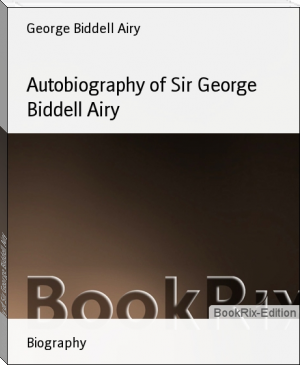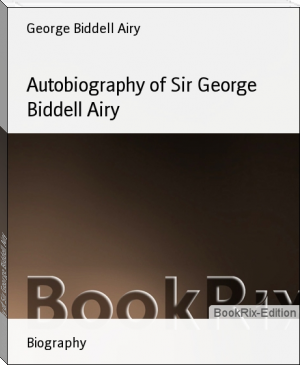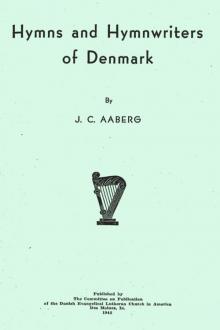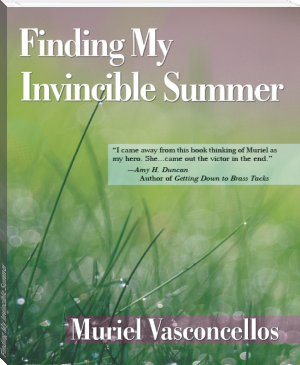Autobiography of Sir George Biddell Airy, George Biddell Airy [dark books to read TXT] 📗

- Author: George Biddell Airy
Book online «Autobiography of Sir George Biddell Airy, George Biddell Airy [dark books to read TXT] 📗». Author George Biddell Airy
source of anxiety. The form which their anomalies appear to take is that of a special or peculiar value of the dip given by each separate needle. With one of the 9-inch needles, the result always differs about a quarter of a degree from that of the others. I can see nothing in its mechanical construction to explain this.--Reference is made to the spontaneous currents through the wires of telegraph companies, which are frequently violent and always occur at the times of magnetic storms, and the Report continues 'It may be worth considering whether it would ever be desirable to establish in two directions at right angles to each other (for instance, along the Brighton Railway and along the North Kent Railway) wires which would photographically register in the Royal Observatory the currents that pass in these directions, exhibiting their indications by photographic curves in close juxtaposition with the registers of the magnetic elements.'--In connection with the Reduction of the Greenwich Lunar Observations from 1831 to 1851, the Report states that 'The comparison of Hansen's Lunar Tables with the Greenwich Observations, which at the last Visitation had been completed for one year only, has now been finished for the twelve years 1847 to 1858. The results for the whole period agree entirely, in their general spirit, with those for the year 1852 cited in the last Report. The greatest difference between the merits of Burckhardt's and Hansen's Tables appears in the Meridional Longitudes 1855, when the proportion of the sum of squares of errors is as 31 (Burckhardt) to 2 (Hansen). The nearest approach is in the Altazimuth Latitudes 1854, when the proportion of the sum of squares of errors is as 12 (Burckhardt) to 5 (Hansen).'--A special Address to the Members of the Board of Visitors has reference to the proposals of M. Struve for (amongst other matters) the improved determination of the longitude of Valencia, and the galvanic determination of the extreme Eastern Station of the British triangles.--On Sept. 13th I circulated amongst the Visitors my Remarks on a Paper entitled 'On the Polar Distances of the Greenwich Transit-Circle, by A. Marth,' printed in the Astronomische Nachrichten; the Paper by Mr Marth was an elaborate attack on the Greenwich methods of observation, and my Remarks were a detailed refutation of his statements.--On Oct. 20th I made enquiry of Sabine as to the advantage of keeping up magnetic observations. On Oct. 22nd he wrote, avoiding my question in some measure, but saying that our instruments must be changed for such as those at Kew (his observatory): I replied, generally declining to act on that advice.--In March and April I was in correspondence with Mr Cowper (First Commissioner of Works, &c.) about the bells of the Westminster Clock; also about the smoky chimneys of the various apartments of the Palace. On Apr. 21st I made my Report on the clock and bells, 20 foolscap pages. I employed a professional musician to examine the tones of the bells.--In November I was writing my book on Probable Errors, &c.--I was engaged on the Tides of Kurrachee and Bombay.--The first examination of Navy telescopes was made for the Admiralty. --Hoch's Paper on Aberration appeared in the Astronomische Nachrichten. This (with others) led to the construction of the water-telescope several years later.--In September I wrote in the Athenaeum against a notion of Sir H. James on the effect of an upheaval of a mountain in changing the Earth's axis. In October I had drawn up a list of days for a possible evagation of the Earth's poles: but apparently nothing was done upon them.
"In this year I was a good deal occupied for the Lighthouse Commission. On Feb. 21st Admiral Hamilton (chairman) applied to me for assistance. In April I went to Chance's Factory in Birmingham on this business. In May I made my report on the Start Lighthouse, after inspection with the Commission. In June, with my son Hubert, I visited the Whitby Lighthouses, and discovered a fault of a singular kind which most materially diminished their power. This discovery led to a general examination of lighthouses by the Trinity Board, to a modification of many, and to a general improvement of system. On June 25th I reported on the Lights at Calais, Cap de Valde, Grisnez, South Foreland, and North Foreland. In August I had been to the North Foreland again, and in September to Calais and the Cap d'Ailly. In October I went with my son Hubert to Aberdeen to see the Girdleness Lighthouse. On Nov. 10th I made a General Report.
"This was the year of the great total solar eclipse visible in Spain. At my representation, the Admiralty placed at my command the large steamship 'Himalaya' to carry about 60 astronomers, British and Foreign. Some were landed at Santander: I with many at Bilbao. The Eclipse was fairly well observed: I personally did not do my part well. The most important were Mr De La Rue's photographic operations. At Greenwich I had arranged a very careful series of observations with the Great Equatoreal, which were fully carried out."
The eclipse expedition to Spain, shortly referred to above, was most interesting, not merely from the importance of the results obtained (and some of the parties were very fortunate in the weather) but from the character of the expedition. It was a wonderful combination of the astronomers of Europe, who were all received on board the 'Himalaya,' and were conveyed together to the coast of Spain. The polyglot of languages was most remarkable, but the utmost harmony and enthusiasm prevailed from first to last, and this had much to do with the general success of the expedition. Those who landed at Bilbao were received in the kindest and most hospitable manner by Mr C.B. Vignoles, the engineer-in-chief of the Bilbao and Tudela Railway, which was then under construction. This gentleman made arrangements for the conveyance of parties to points in the interior of the country which were judged suitable for the observation of the eclipse, and placed all the resources of his staff at the disposal of the expedition in the most liberal manner. The universal opinion was that very great difficulty would have been experienced without the active and generous assistance of Mr Vignoles. It is needless to say that the vote of thanks to Mr Vignoles, proposed by the Astronomer Royal during the return voyage, was passed by acclamation and with a very sincere feeling of gratitude: it was to the effect that 'without the great and liberal aid of Mr C.B. Vignoles, and the disinterested love of science evinced by him on this occasion, the success of the "Himalaya" eclipse expedition could not have been ensured.' There is a graphic and interesting account of the reception of the party at Bilbao given in the 'Life of C.B. Vignoles, F.R.S., Soldier and Civil Engineer,' by O.J. Vignoles, M.A.
Of private history: "On May 26th my venerable friend Arthur Biddell died. He had been in many respects more than a father to me: I cannot express how much I owed to him, especially in my youth.--From June 12th to 15th I visited the Whitby Lighthouses with my son Hubert.--From July 6th to 28th I was in Spain, on the 'Himalaya' expedition, to observe the total eclipse: I was accompanied by my wife, my eldest son, and my eldest daughter.--From Oct. 5th to 18th I went with my son Hubert to Aberdeen to see the Girdleness Lighthouse, making lateral trips to Cumberland in going and returning.--On Dec. 21st I went to Playford."
1861
"In the Report to the Visitors there is great complaint of want of room. 'With increase of computations, we want more room for computers; with our greatly increased business of Chronometers and Time-Distribution, we are in want of a nearly separate series of rooms for the Time-Department: we want rooms for book-stores; and we require rooms for the photographic operations and the computations of the Magnetic Department.'--The Report gives a curious history of Dr Bradley's Observations, which in 1776 had been transferred to the University of Oxford, and proceeds thus: 'More lately, I applied (in the first instance through Lord Wrottesley) to the Vice-Chancellor, Dr Jeune, in reference to the possibility of transferring these manuscripts to the Royal Observatory.... Finally, a decree for the transfer of the manuscript observations to the Royal Observatory, without any condition, was proposed to Convocation on May 2nd, and was passed unanimously. And on May 7th my Assistant, Mr Dunkin, was sent to Oxford to receive them. And thus, after a delay of very nearly a century, the great work of justice is at length completed, and the great gap in our manuscript observations is at length filled up.'--With reference to the Transit Circle, it had been remarked that the Collimators were slightly disturbed by the proximity of the gas-flames of their illuminators, and after various experiments as to the cause of it, the Report proceeds thus: 'To my great surprise, I found that the disturbance was entirely due to the radiation of the flame upon a very small corner (about 16 square inches) of the large and massive stone on which the collimator is planted. The tin plates were subsequently shaped in such a manner as to protect the stone as well as the metal; and the disturbance has entirely ceased.' --Regarding the large S.E. Equatoreal, the Report states that 'On the character of its object-glass I am now able to speak, first, from the examination of Mr Otto Struve, made in a favourable state of atmosphere; secondly, from the examinations of my Assistants (I have not myself obtained a sight of a test-object on a night of very good definition). It appears to be of the highest order. The small star of gamma Andromedae is so far separated as to shew a broad dark space between its components. Some blue colour is shewn about the bright planets.'--It is noted in the Report that 'The Equatoreal observations of the Solar Eclipse are completely reduced; and the results are valuable. It appears from them that the error in right ascension of Burckhardt's Lunar Tables at the time of the eclipse amounted to about 38"; while that of Hansen's (ultimately adopted by Mr Hind for the calculation of the eclipse) did not exceed 3".'--With regard to Chronometers it is stated that 'By use of the Chronometer Oven, to which I have formerly alluded, we have been able to give great attention to the compensation. I have reason to think that we are producing a most beneficial effect on the manufacture and adjustment of chronometers in general.'--With regard to the Cape of Good Hope Observatory and Survey, the Admiralty enquire of me when the Survey work will be completed, and I enquire of Maclear 'How is the printing of your Survey Work?' In 1862 I began to press it strongly, and in 1863 very strongly.--I introduced a method (constantly pursued since that time at the Royal Observatory) for computing interpolations without changes of sign.--I had correspondence with Herschel and Faraday, on the possible effect of the Sun's radiant heat on the sea, as explaining the curve of diurnal magnetic inequality. (That diurnal inequality was inferred from the magnetic reductions 1848-1857, which were terminated in 1860.)--Regarding the proposal of hourly time-signals on the Start Point, I consulted telegraph engineers upon the practical points, and on Dec. 21st I proposed a formal scheme, in complete detail. (The matter has been repeatedly brought before the Admiralty, but has been uniformly rejected.)--I was engaged on the question of the bad ocular vision of two or three persons.--The British Association Meeting was held at Manchester: I was President of Section A. I gave a Lecture on the Eclipse of
"In this year I was a good deal occupied for the Lighthouse Commission. On Feb. 21st Admiral Hamilton (chairman) applied to me for assistance. In April I went to Chance's Factory in Birmingham on this business. In May I made my report on the Start Lighthouse, after inspection with the Commission. In June, with my son Hubert, I visited the Whitby Lighthouses, and discovered a fault of a singular kind which most materially diminished their power. This discovery led to a general examination of lighthouses by the Trinity Board, to a modification of many, and to a general improvement of system. On June 25th I reported on the Lights at Calais, Cap de Valde, Grisnez, South Foreland, and North Foreland. In August I had been to the North Foreland again, and in September to Calais and the Cap d'Ailly. In October I went with my son Hubert to Aberdeen to see the Girdleness Lighthouse. On Nov. 10th I made a General Report.
"This was the year of the great total solar eclipse visible in Spain. At my representation, the Admiralty placed at my command the large steamship 'Himalaya' to carry about 60 astronomers, British and Foreign. Some were landed at Santander: I with many at Bilbao. The Eclipse was fairly well observed: I personally did not do my part well. The most important were Mr De La Rue's photographic operations. At Greenwich I had arranged a very careful series of observations with the Great Equatoreal, which were fully carried out."
The eclipse expedition to Spain, shortly referred to above, was most interesting, not merely from the importance of the results obtained (and some of the parties were very fortunate in the weather) but from the character of the expedition. It was a wonderful combination of the astronomers of Europe, who were all received on board the 'Himalaya,' and were conveyed together to the coast of Spain. The polyglot of languages was most remarkable, but the utmost harmony and enthusiasm prevailed from first to last, and this had much to do with the general success of the expedition. Those who landed at Bilbao were received in the kindest and most hospitable manner by Mr C.B. Vignoles, the engineer-in-chief of the Bilbao and Tudela Railway, which was then under construction. This gentleman made arrangements for the conveyance of parties to points in the interior of the country which were judged suitable for the observation of the eclipse, and placed all the resources of his staff at the disposal of the expedition in the most liberal manner. The universal opinion was that very great difficulty would have been experienced without the active and generous assistance of Mr Vignoles. It is needless to say that the vote of thanks to Mr Vignoles, proposed by the Astronomer Royal during the return voyage, was passed by acclamation and with a very sincere feeling of gratitude: it was to the effect that 'without the great and liberal aid of Mr C.B. Vignoles, and the disinterested love of science evinced by him on this occasion, the success of the "Himalaya" eclipse expedition could not have been ensured.' There is a graphic and interesting account of the reception of the party at Bilbao given in the 'Life of C.B. Vignoles, F.R.S., Soldier and Civil Engineer,' by O.J. Vignoles, M.A.
Of private history: "On May 26th my venerable friend Arthur Biddell died. He had been in many respects more than a father to me: I cannot express how much I owed to him, especially in my youth.--From June 12th to 15th I visited the Whitby Lighthouses with my son Hubert.--From July 6th to 28th I was in Spain, on the 'Himalaya' expedition, to observe the total eclipse: I was accompanied by my wife, my eldest son, and my eldest daughter.--From Oct. 5th to 18th I went with my son Hubert to Aberdeen to see the Girdleness Lighthouse, making lateral trips to Cumberland in going and returning.--On Dec. 21st I went to Playford."
1861
"In the Report to the Visitors there is great complaint of want of room. 'With increase of computations, we want more room for computers; with our greatly increased business of Chronometers and Time-Distribution, we are in want of a nearly separate series of rooms for the Time-Department: we want rooms for book-stores; and we require rooms for the photographic operations and the computations of the Magnetic Department.'--The Report gives a curious history of Dr Bradley's Observations, which in 1776 had been transferred to the University of Oxford, and proceeds thus: 'More lately, I applied (in the first instance through Lord Wrottesley) to the Vice-Chancellor, Dr Jeune, in reference to the possibility of transferring these manuscripts to the Royal Observatory.... Finally, a decree for the transfer of the manuscript observations to the Royal Observatory, without any condition, was proposed to Convocation on May 2nd, and was passed unanimously. And on May 7th my Assistant, Mr Dunkin, was sent to Oxford to receive them. And thus, after a delay of very nearly a century, the great work of justice is at length completed, and the great gap in our manuscript observations is at length filled up.'--With reference to the Transit Circle, it had been remarked that the Collimators were slightly disturbed by the proximity of the gas-flames of their illuminators, and after various experiments as to the cause of it, the Report proceeds thus: 'To my great surprise, I found that the disturbance was entirely due to the radiation of the flame upon a very small corner (about 16 square inches) of the large and massive stone on which the collimator is planted. The tin plates were subsequently shaped in such a manner as to protect the stone as well as the metal; and the disturbance has entirely ceased.' --Regarding the large S.E. Equatoreal, the Report states that 'On the character of its object-glass I am now able to speak, first, from the examination of Mr Otto Struve, made in a favourable state of atmosphere; secondly, from the examinations of my Assistants (I have not myself obtained a sight of a test-object on a night of very good definition). It appears to be of the highest order. The small star of gamma Andromedae is so far separated as to shew a broad dark space between its components. Some blue colour is shewn about the bright planets.'--It is noted in the Report that 'The Equatoreal observations of the Solar Eclipse are completely reduced; and the results are valuable. It appears from them that the error in right ascension of Burckhardt's Lunar Tables at the time of the eclipse amounted to about 38"; while that of Hansen's (ultimately adopted by Mr Hind for the calculation of the eclipse) did not exceed 3".'--With regard to Chronometers it is stated that 'By use of the Chronometer Oven, to which I have formerly alluded, we have been able to give great attention to the compensation. I have reason to think that we are producing a most beneficial effect on the manufacture and adjustment of chronometers in general.'--With regard to the Cape of Good Hope Observatory and Survey, the Admiralty enquire of me when the Survey work will be completed, and I enquire of Maclear 'How is the printing of your Survey Work?' In 1862 I began to press it strongly, and in 1863 very strongly.--I introduced a method (constantly pursued since that time at the Royal Observatory) for computing interpolations without changes of sign.--I had correspondence with Herschel and Faraday, on the possible effect of the Sun's radiant heat on the sea, as explaining the curve of diurnal magnetic inequality. (That diurnal inequality was inferred from the magnetic reductions 1848-1857, which were terminated in 1860.)--Regarding the proposal of hourly time-signals on the Start Point, I consulted telegraph engineers upon the practical points, and on Dec. 21st I proposed a formal scheme, in complete detail. (The matter has been repeatedly brought before the Admiralty, but has been uniformly rejected.)--I was engaged on the question of the bad ocular vision of two or three persons.--The British Association Meeting was held at Manchester: I was President of Section A. I gave a Lecture on the Eclipse of
Free e-book «Autobiography of Sir George Biddell Airy, George Biddell Airy [dark books to read TXT] 📗» - read online now
Similar e-books:





Comments (0)